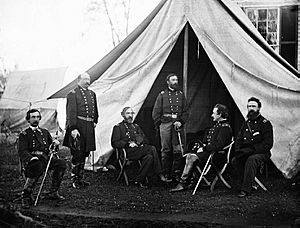George Sykes facts for kids
Quick facts for kids
George Sykes
|
|
|---|---|

General George Sykes
|
|
| Nickname(s) | Tardy George Slow Trot Sykes |
| Born | October 9, 1822 Dover, Delaware |
| Died | February 8, 1880 (aged 57) Fort Brown, Texas |
| Place of burial |
West Point Cemetery
West Point, New York |
| Allegiance | United States of America Union |
| Service/ |
United States Army Union Army |
| Years of service | 1842–1880 |
| Rank | |
| Commands held | V Corps 20th U.S. Infantry Regiment |
| Battles/wars | Second Seminole War Mexican–American War American Civil War |
George Sykes (born October 9, 1822 – died February 8, 1880) was an important officer in the United States Army. He became a general for the Union Army during the American Civil War.
He finished his studies at the United States Military Academy in 1842. Sykes served in many wars, including the Second Seminole War and the Mexican–American War.
During the Civil War, he led the 2nd Division of the V Corps. This was part of the Army of the Potomac. He commanded this group during major battles like the Peninsula Campaign, Second Battle of Bull Run, Battle of Antietam, Battle of Fredericksburg, and Battle of Chancellorsville.
Sykes took charge of the V Corps on June 28, 1863. This happened after Major General George G. Meade became the overall commander of the army. Sykes's Corps fought bravely at the Battle of Gettysburg on July 2. Later, he was criticized for his actions at the Battle of Mine Run. He was removed from command in March 1864 and sent to Kansas. Sykes stayed in the army after the war and passed away in 1880.
Early Life and Military Start
Sykes was born in Dover, Delaware. He went to the United States Military Academy and graduated in 1842. He was 39th in his class of 56 cadets.
During his time as a cadet, he got the nicknames "Tardy George" and "Slow Trot" Sykes. He became a brevet second lieutenant in the 3rd U.S. Infantry. He served in the Second Seminole War and the Mexican–American War.
Sykes was promoted to captain for his brave actions at the Battle of Cerro Gordo. After the Mexican War, he became a member of the Aztec Club of 1847. Sykes continued his service, fighting Native Americans, mostly in New Mexico. He became a full captain in 1855. His last assignment before the Civil War was at Fort Clark, Texas.
Serving in the Civil War
When the Civil War began, Sykes was made a major in the new 14th U.S. Infantry. At the First Battle of Bull Run, he led a group of eight companies from different regular army regiments. These were the only regular soldiers on the battlefield.
After Bull Run, Sykes was given command of a brigade of regular soldiers. He was promoted to brigadier general of volunteers on September 28. He led his regular troops in the Peninsula Campaign. In May 1862, he became a division commander in the new V Corps. His soldiers, who called themselves "Sykes' Regulars," fought very well at Gaines' Mill. They defended their position during the Seven Days Battles before the Union line broke elsewhere.
Sykes was the only division commander in the Army of the Potomac who was not promoted to major general after the Seven Days Battles. He continued to lead his division at Second Bull Run, Antietam, and Fredericksburg. His division was not heavily involved in the last two battles.
At Chancellorsville, his regular soldiers led the attack into the Confederate rear. Sykes' division fought against Major General Lafayette McLaws' division. Sykes' division had to retreat after being attacked on their right side. The army commander, Major General Joseph Hooker, then pulled back the advance. Sykes' men did not fight for the rest of that campaign.
Sykes finally became a major general of volunteers on November 29, 1862. None of these battles showed him as a very aggressive leader. When corps commander Major General George G. Meade was promoted to lead the Army of the Potomac on June 28, 1863, Sykes took command of the V Corps.

At the Battle of Gettysburg, Sykes' corps helped the struggling III Corps. This was on the Union's left side. In his 1st Division, Colonel Strong Vincent and the 20th Maine Infantry under Colonel Joshua Lawrence Chamberlain bravely defended Little Round Top. His 3rd Division, the Pennsylvania Reserves, led by Brigadier General Samuel W. Crawford, attacked from Little Round Top. They pushed the Confederates across the "Valley of Death." This ended the fierce fighting in the Wheatfield. However, there is not much information showing Sykes' personal contributions in these specific actions.
On October 16, 1863, Sykes was promoted to lieutenant colonel in the regular army.
During the Battle of Mine Run in late 1863, General Meade was not happy with Sykes' performance. Meade and general-in-chief Ulysses S. Grant felt Sykes was not the right person for the upcoming Overland Campaign. So, in the spring of 1864, Sykes was removed from command of the V Corps. He was sent to a less important duty in the Department of Kansas. During Price's Raid in 1864, James G. Blunt replaced him.
After the War
After the Civil War, Sykes left the volunteer service. He returned to serve in the regular army in 1866. As a Lieutenant Colonel, he served in the 5th U.S. Infantry. Sykes was promoted to colonel on January 12, 1868. He then received command of the 20th U.S. Infantry.
He commanded at various military posts from Minnesota to Texas. He died while on duty in Texas at Fort Brown on February 8, 1880, at 57 years old. He was buried in West Point Cemetery, West Point, New York.
See also
 In Spanish: George Sykes para niños
In Spanish: George Sykes para niños


